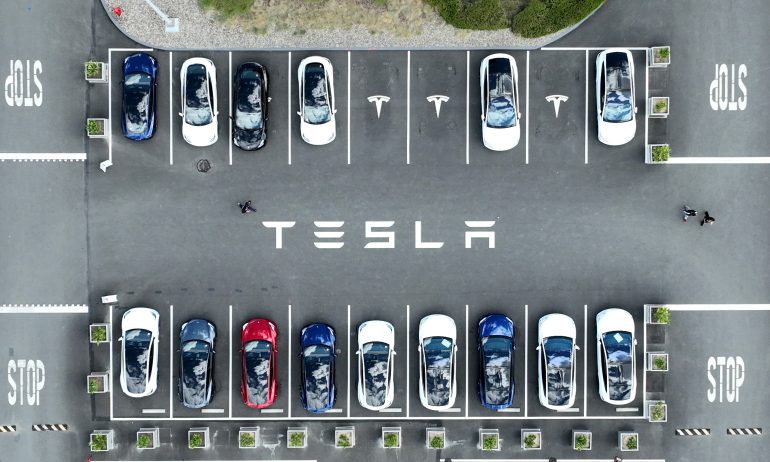The Painful Truth of Investing in EV Companies

Many or all of the products featured here are from our partners who compensate us. This influences which products we write about and where and how the product appears on a page. However, this does not influence our evaluations. Our opinions are our own. Here is a list of our partners and here's how we make money.
The investing information provided on this page is for educational purposes only. NerdWallet, Inc. does not offer advisory or brokerage services, nor does it recommend or advise investors to buy or sell particular stocks, securities or other investments.
With the exception of Tesla, EV stocks have performed dismally in 2023.
Rivian, for instance, is down 21% year to date and has slipped almost 64% since last April. Proterra has performed even worse, dropping 67% YTD and almost 82% since this time last year.
And it’s not just U.S. electric vehicle makers that are struggling. The S&P Kensho Electric Vehicles Index, which measures top leaders in the global EV market, has also dropped about 5% YTD and 37% since last April.
To put that in perspective, many traditional carmakers, such as Ford and General Motors, have seen modest but positive gains in 2023. And the S&P 500 is up roughly 7% YTD.
Some may think it's just a bad year for EV makers. After all, interest rates are high, consumers are sheepish about taking out auto loans, and supply constraints for battery metals have made the cost of producing EVs exorbitantly high.
But these problems aren’t unique to 2023. In fact, high borrowing costs have only exacerbated what has been a painful truth of EV companies since the beginning: Electric cars are still too expensive for consumers to buy on a mass scale, even if EV companies rev up production. Worse — they’re also too expensive for many EV companies to make.
Let’s look at these problems separately.
NerdWallet rating 4.9 /5 | NerdWallet rating 5.0 /5 | NerdWallet rating 4.1 /5 |
Fees $0 per online equity trade | Fees $0 per trade | Fees $0 per trade |
Account minimum $0 | Account minimum $0 | Account minimum $0 |
Promotion None no promotion available at this time | Promotion None no promotion available at this time | Promotion Get up to $700 when you open and fund a J.P. Morgan Self-Directed Investing account with qualifying new money. |
Production of electric vehicles is outpacing sales
Nowhere is this more clear than with Tesla.
On April 2, Tesla reported a first-quarter delivery number of 422,875 vehicles. In other words, 422,875 consumers ordered a Tesla and didn’t cancel their order before the car arrived. In the same period, Tesla also produced 440,808 vehicles. That means the company produced roughly 17,933 more vehicles than it was able to sell.
This isn’t a new trend. Since about mid-2022, demand for Tesla models, as measured by the size of its order backlog, has declined drastically — even as the raw number of Teslas sold has grown each year. According to data obtained by Troy Teslike — an independent analyst of Tesla production and delivery estimates — Tesla’s backlog orders have dropped 77% since March 2022: from 470,000 units in March 2022 to 103,000 units in March this year.
Tesla’s competitors have also struggled to sell vehicles. For instance, EV sedan maker Lucid Group produced 7,180 vehicles in 2022, but it delivered only 4,369. And the EV truck producer Rivian produced 24,337 trucks but delivered 20,332.
Part of the problem is that all-EV companies are beginning to cede market share to legacy carmakers, like Ford and Chevy. In 2022, Ford was the second-largest EV maker, with a sale of 61,575 vehicles, while Chevy sold 38,120 units of the Bolt. Ford even sold 15,617 units of its F-150 Lightning, which competes directly with Rivian's trucks.
Another problem is price. In a high-interest-rate environment, which makes car loans more expensive, car shoppers may not be able to purchase EVs at the rate they’re being produced. For example, Rivian’s most affordable truck, the R1T, costs $69,300, while Ford’s F-150 Lightning is $59,974. By contrast, a gas-engine Ford Maverick XLT is $22,595 — 67% cheaper than Rivian’s truck.
Tesla has already cut prices five times since January and may cut them again later this year. While that may be good news for EV buyers, it’s bad news for investors: Lower prices mean EV companies retain less profit on every car they sell, narrowing profit margins that for some don’t even exist yet.
That leads us to the second problem with EV stocks.
Most EV companies aren’t profitable
Tesla does have a leg up on nearly all of its EV competitors: The company is actually making money. Everyone else is bleeding cash.
For example, Rivian reportedly lost $6.8 billion in 2022 and estimates it will lose another $4.3 billion in 2023. Looking into its most recent quarterly statement, we see the company generated roughly $1.7 billion in revenue but spent around $4.8 billion to produce 24,337 trucks.
How much did Rivian lose per truck? $1.7 billion would have been roughly $84,000 in revenue per vehicle (for the 20,332 it sold). However, it spent $4.8 billion to produce 24,337 vehicles, which comes out to around $197,000 per truck. That means Rivian lost roughly $113,000 per sale.
Other EV producers aren’t doing much better. In 2022, Lucid Group lost around $2.6 billion on a revenue of $608 million. Even Ford reported losing roughly $2.1 billion on its EV sales last year.
One reason these companies are bleeding cash is the cost of battery materials. EV companies need critical metals — such as lithium, cobalt, nickel and copper — to build lithium-ion batteries. These metals are in high demand, not only because EV companies need them but also because other industries need them: solar panel manufacturers, wind turbine companies, chipmakers, data centers, battery storage facilities and 5G network providers all need critical metals.
The U.S. has deposits of lithium in Nevada, but it currently doesn’t have sufficient mining operations to extract large quantities. That means EV companies are depending on foreign mining companies to extract and process metals. Toss in the fact that U.S. EV makers also depend on China to then make these metals into batteries and it’s not hard to see why production is so expensive. Even Tesla, which has invested heavily in its manufacturing capacity, still depends on the Chinese mining company Ganfeng for some of its lithium.
Should you invest in EV stocks in 2023?
It’s a hard truth to swallow, but some EV startups won’t be around 10 to 15 years from now.
If you decide to invest in EV stocks in 2023, be sure to look closely at the EV company's fundamentals: its revenues, costs and the likelihood of achieving profitability. Some EV stocks will look cheap this year, but if they don’t have long-term potential, they might not be a smart investment.
» Learn more: How to research stocks The author owned shares in Tesla at the time of publication.
Image: Justin Sullivan/Getty Images News via Getty Images
On a similar note...





